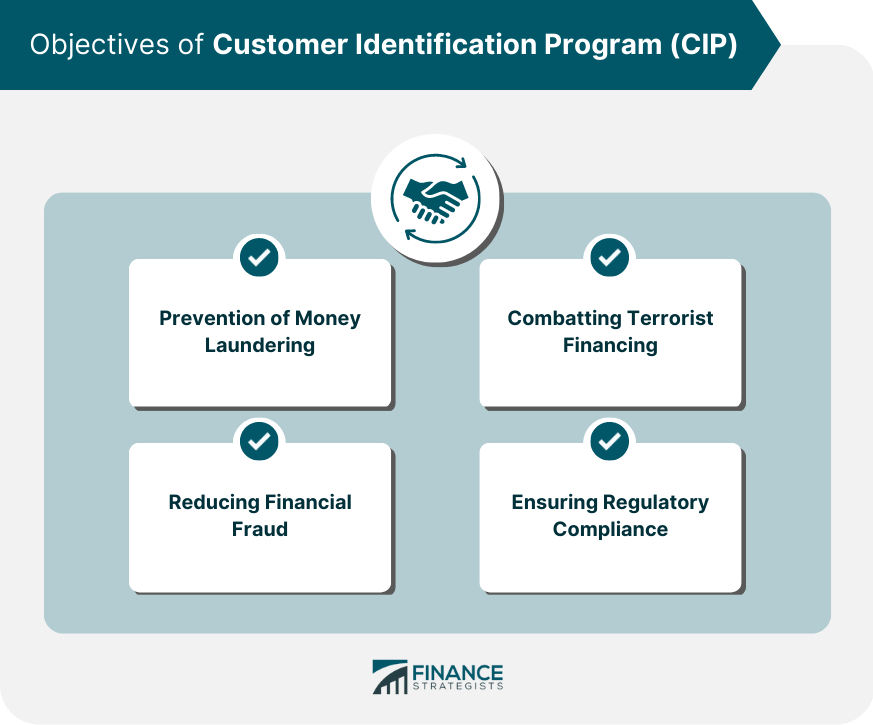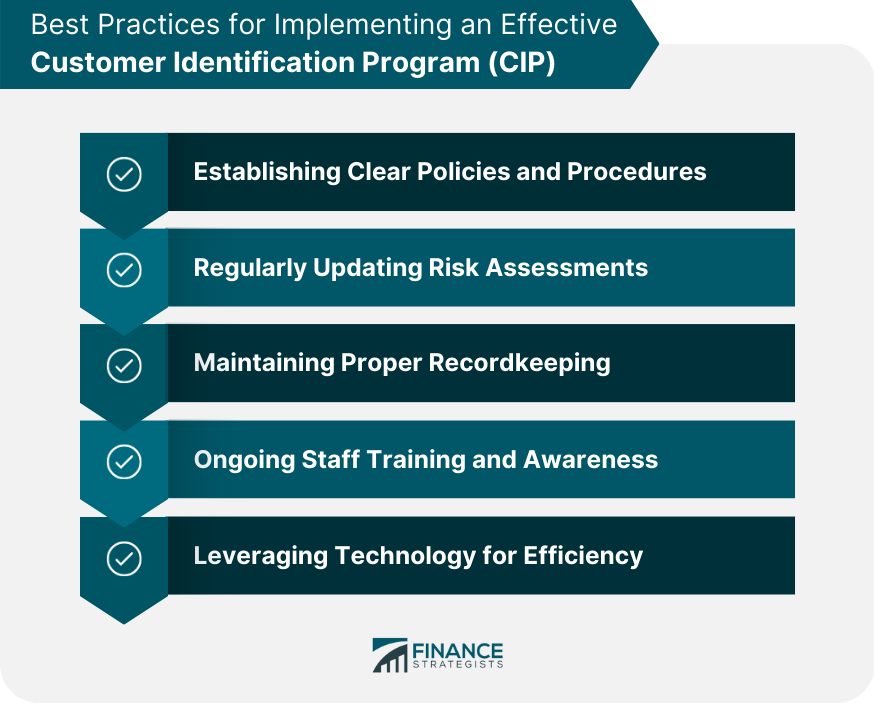The Customer Identification Program is a set of requirements and procedures that financial institutions must follow to verify the identity of their customers. These regulations are designed to prevent money laundering, terrorist financing, and other financial crimes. CIP plays a crucial role in maintaining the financial system's integrity by ensuring that financial institutions conduct business with legitimate customers and comply with regulatory requirements. CIP is governed by the USA PATRIOT Act and the Financial Crimes Enforcement Network (FinCEN), which enforce regulations to combat money laundering, terrorist financing, and other financial crimes. The following are the objectives of a Customer Identification Program (CIP): CIP aims to prevent money laundering by verifying customer identities and monitoring transactions to identify suspicious activities. CIP helps identify and report transactions that may be linked to terrorist financing activities. By verifying customer identities and monitoring transactions, CIP helps detect and prevent various forms of financial fraud. CIP ensures that financial institutions adhere to relevant regulations, thus protecting them from legal and reputational risks. The following are the key components of a Customer Identification Programs: Financial institutions typically verify customer identities using government-issued documents such as passports, driver's licenses, or national ID cards. There are three main methods of identity verification: Documentary Verification: Financial institutions can verify customer identities by examining physical or digital copies of identification documents. Non-Documentary Verification: To verify customer identities, financial institutions may also use non-documentary methods, such as credit reports, public databases, or customer interviews. Additional Verification for High-Risk Customers: High-risk customers may require enhanced due diligence, which may involve obtaining additional documentation or information. Financial institutions must maintain records of customer identification documents, account opening documents, and transaction records. These records must be retained for a period, usually five years, per regulatory requirements. Financial institutions must notify customers about the CIP and the information collected for identity verification purposes. The notice can be delivered through various means, such as in-person, via mail, or electronically. Below are some details involved in a risk-based approach to Customer Identification Programs: Risk assessment is essential for tailoring CIP requirements based on the specific risks associated with a customer, product, or service. Key factors to consider in risk assessment include: Different customer types, such as individuals, businesses, or foreign entities, may pose varying levels of risk. Certain products or services, such as wire transfers or private banking, may carry a higher risk of money laundering or terrorist financing. Customers from high-risk jurisdictions may require enhanced due diligence. Unusual or high-value transactions may indicate a higher risk of financial crimes. Financial institutions must apply enhanced due diligence measures for customers identified as high-risk. Risk assessments should be reviewed and updated regularly to ensure their accuracy and effectiveness. There are some compliance and regulatory expectations involved when establishing Customer Identification Programs. Financial institutions must undergo regular regulatory examinations and audits to ensure compliance with CIP requirements. Employees must receive ongoing training on CIP requirements and best practices to ensure effective implementation and compliance. Financial institutions that fail to comply with CIP requirements may face significant penalties, including fines and legal actions. Below are some details on how technology impacts and affects Customer Identification Programs: Technology can help streamline CIP processes through electronic identity verification, which uses digital methods to validate customer identification documents and data. Technology can also assist in maintaining accurate and up-to-date records through automated recordkeeping systems, reducing the risk of human error. There are some advantages to using technology in managing a Customer Identification Program (CIP). Technology can enhance the accuracy of identity verification and recordkeeping processes, reducing the risk of errors and fraud. Automation can significantly reduce the manual effort required to verify customer identities and maintain records, allowing staff to focus on other critical tasks. Technology can help improve the customer experience by simplifying and speeding up the identity verification process. Below are some best practices that lead to the effective implementation of a Customer Identification Program. Financial institutions should establish clear and comprehensive policies and procedures to guide their CIP implementation and ensure compliance with regulatory requirements. Risk assessments should be reviewed and updated regularly to ensure they remain accurate and effective in addressing the evolving risks in the financial industry. Financial institutions must maintain accurate and up-to-date records of customer identification documents and transaction history, as per regulatory requirements. Employees should receive regular training on CIP requirements and best practices to ensure they understand their roles and responsibilities in maintaining compliance. Financial institutions should leverage technology to streamline CIP processes and enhance their overall effectiveness and efficiency. The Customer Identification Program is a set of requirements and procedures that financial institutions must follow to verify the identity of their customers, with the objective of preventing money laundering, terrorist financing, and other financial crimes. The key components of a CIP include identity verification, recordkeeping, and customer notice, with a risk-based approach to tailor requirements based on specific risks. Compliance with CIP requirements is essential to avoid significant penalties and legal actions, with ongoing staff training and awareness and leveraging technology for efficiency as best practices for effective implementation. CIP plays a crucial role in maintaining the financial system's integrity and protecting financial institutions from legal and reputational risks.What Is a Customer Identification Program (CIP)?
Objectives of CIP
Prevention of Money Laundering
Combatting Terrorist Financing
Reducing Financial Fraud
Ensuring Regulatory Compliance

Key Components of a CIP
Identity Verification
Recordkeeping
Customer Notice
Risk-Based Approach to CIP
Importance of Risk Assessment
Factors to Consider in Risk Assessment
Customer Type
Product/Service Type
Geographic Location
Transaction Type
Implementing Risk-Based Controls
CIP Compliance and Regulatory Expectations
Regulatory Examinations and Audits
Training Requirements for Staff
Penalties for Non-Compliance
Technology and CIP
Role of Technology in Streamlining CIP Processes
Advantages of Using Technology in CIP
Improved Accuracy
Reduced Manual Effort
Enhanced Customer Experience
Best Practices for Implementing an Effective CIP
Establishing Clear Policies and Procedures
Regularly Updating Risk Assessments
Maintaining Proper Recordkeeping
Ongoing Staff Training and Awareness
Leveraging Technology for Efficiency

Conclusion
Customer Identification Program (CIP) FAQs
A customer identification program (CIP) is a set of procedures and processes designed to verify the identity of customers opening accounts with a financial institution.
A CIP is necessary to comply with anti-money laundering (AML) regulations and to prevent financial crimes such as terrorist financing, money laundering, and identity theft.
A CIP requires customers to provide their name, date of birth, address, and identification number, such as a Social Security number or passport number.
Financial institutions, including banks, credit unions, and broker-dealers, are responsible for implementing a CIP to comply with AML regulations.
Financial institutions are required to deny the account opening or suspend the account until the customer provides the required information.
True Tamplin is a published author, public speaker, CEO of UpDigital, and founder of Finance Strategists.
True is a Certified Educator in Personal Finance (CEPF®), author of The Handy Financial Ratios Guide, a member of the Society for Advancing Business Editing and Writing, contributes to his financial education site, Finance Strategists, and has spoken to various financial communities such as the CFA Institute, as well as university students like his Alma mater, Biola University, where he received a bachelor of science in business and data analytics.
To learn more about True, visit his personal website or view his author profiles on Amazon, Nasdaq and Forbes.











